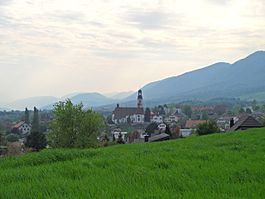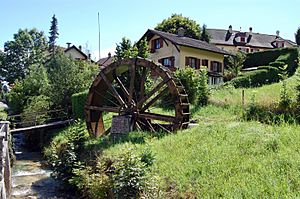Oberdorf, Solothurn facts for kids
Quick facts for kids
Oberdorf
|
||
|---|---|---|

Center of Oberdorf with church
|
||
|
||
| Country | Switzerland | |
| Canton | Solothurn | |
| District | Lebern | |
| Area | ||
| • Total | 11.91 km2 (4.60 sq mi) | |
| Elevation | 559 m (1,834 ft) | |
| Population
(Dec 2020 )
|
||
| • Total | 1,776 | |
| • Density | 149.12/km2 (386.21/sq mi) | |
| Postal code |
4515
|
|
| Surrounded by | Bellach, Gänsbrunnen, Langendorf, Lommiswil, Rüttenen, Selzach, Welschenrohr | |
Oberdorf is a small town, also called a municipality, in the Lebern district. It is located in the canton of Solothurn in Switzerland.
Contents
History of Oberdorf
Oberdorf was first mentioned in official records way back in 1305. Its name, Oberdorf, has stayed the same ever since!
Geography and Landscape
Oberdorf covers an area of about 11.95 square kilometers (4.6 square miles). A large part of this land, about 68%, is covered by forests. About 25% of the area is used for farming.
A smaller part, around 7%, has buildings and roads. A tiny bit, less than 1%, is made up of rivers or unproductive land.
The town sits on a flat area at the bottom of the Weissenstein mountain, which is part of the Jura mountains. Oberdorf is about 559 meters (1,834 feet) above sea level. It is located about 3.5 kilometers (2.2 miles) northwest of Solothurn, the capital city of the Solothurn canton.
Coat of Arms
The coat of arms for Oberdorf shows Saint Michael on a blue background. Saint Michael is silver with his wings spread. He holds a sword in one hand and scales in the other.
Population and People
Oberdorf has a population of about 1,700 people. As of 2008, about 5.9% of the people living there were foreign nationals. Over ten years, from 1999 to 2009, the population grew by about 5.6%.
Most people in Oberdorf speak German. About 95% of the population speaks German. A small number of people also speak French or Italian.
In 2008, the population was almost evenly split between males and females. About 48.3% were male and 51.7% were female. Most residents are Swiss citizens.
Many people living in Oberdorf were born there or in the same canton. About 25% were born in Oberdorf itself. Another 35% were born in the Solothurn canton. About 27% were born elsewhere in Switzerland, and 10.5% were born outside of Switzerland.
Age Groups
The population of Oberdorf includes people of all ages.
- About 7% are young children (0-6 years old).
- About 17% are teenagers (7-19 years old).
- About 3% are young adults (20-24 years old).
- About 30% are adults (25-44 years old).
- About 27% are older adults (45-64 years old).
- About 12% are seniors (65-79 years old).
- About 4% are very elderly (over 80 years old).
Homes and Households
In 2000, there were 621 private homes in Oberdorf. On average, about 2.5 people lived in each home.
- About 20% of homes had only one person living in them.
- Some homes had five or more people.
- Many homes were lived in by married couples, with or without children.
- There were also single parents living with their children.
Most of the buildings in Oberdorf are single-family homes. In 2000, about 73% of all inhabited buildings were single-family homes. Many of these homes were built between 1981 and 2000.
There were 681 apartments in the town. Most apartments had four rooms. About 90% of these apartments were lived in all the time.
Population Changes Over Time
The population of Oberdorf has changed a lot over the years. This chart shows how the number of people living in Oberdorf has grown since 1850.

Important Heritage Sites
The parish and pilgrimage church in Oberdorf is a very important building. It is listed as a Swiss heritage site of national significance. This means it's a special place that is protected because of its history and culture. The whole village of Oberdorf is also part of the Inventory of Swiss Heritage Sites.
Economy and Jobs
In 2010, the unemployment rate in Oberdorf was very low, at only 2%. This means most people who wanted a job had one.
Many people in Oberdorf work in different types of jobs:
- Some work in the primary sector, like farming.
- Others work in the secondary sector, which includes manufacturing and construction.
- The largest number of people work in the tertiary sector, which includes services like sales, transportation, hotels, restaurants, and healthcare.
In 2008, there were 301 full-time equivalent jobs in Oberdorf. Most of these jobs were in the service industry. For example, many people worked in hotels or restaurants, or in healthcare.
Many people who live in Oberdorf travel to other towns for work. In 2000, about 655 people commuted out of Oberdorf for their jobs. About 24% of workers used public transportation, and over half (52.6%) used a private car to get to work.
Religion
Based on the 2000 census, people in Oberdorf follow different religions:
- About 39.6% are Roman Catholic.
- About 36.4% belong to the Swiss Reformed Church.
- A small number of people belong to other Christian churches, including Orthodox and Christian Catholic.
- About 1% of the population is Islamic.
- A very small number are Buddhist or follow other religions.
- About 17% of the population said they did not belong to any church or were agnostic or atheist.
Education System
Education is important in Oberdorf. About 39% of the population has finished upper secondary education. This is like high school. About 19.7% have gone on to higher education, such as a university or a specialized college (a Fachhochschule).
During the 2010–2011 school year, there were 165 students in the Oberdorf school system.
- Young children can attend two years of non-mandatory Kindergarten. In 2010-2011, there were 31 children in kindergarten.
- Students then attend six years of primary school. There were 134 students in primary school in Oberdorf.
- For secondary school, students from Oberdorf attend schools in a nearby town.
In 2000, most students from Oberdorf went to school outside the municipality.
Images for kids
See also
 In Spanish: Oberdorf (Soleura) para niños
In Spanish: Oberdorf (Soleura) para niños











